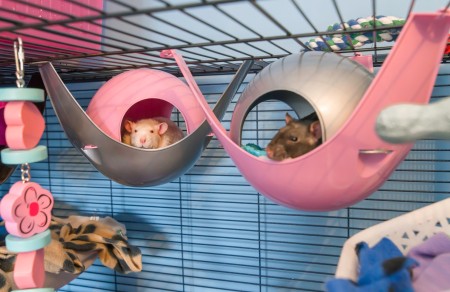In many ways, setting up for a pet rat is similar to preparing housing for other small furries -- rabbits, guinea pigs, or ferrets.
You can house your rat in a cage or a large aquarium. Cages are generally more popular because they offer climbing opportunities and good ventilation -- aquariums have poorer circulation, which can lead to health problems for your rat. If you choose to outfit a cage for your rat, make sure that the bars are close enough that a baby or young rat can't squeeze out.
When it comes to cage size, a good rule of thumb is to allow two cubic feet for each rat. But really, the bigger the cage, the better. Your rats will love having the space to climb and play!
A plastic tray for litter at the bottom of your rats' living area will make life a little easier for you -- especially when it comes to cleaning. Your rat habitat should be thoroughly cleaned every three to five days. All tubes, toys, shelves, and litter trays should be removed and washed. You may need to pick up food waste and excrement every day. Soiled or wet bedding should be removed as soon as you notice it.
Your rat habitat will need a nest box -- somewhere for your rat to sleep. Choose a bed that is warm and secure, like a small plastic basket or even a cardboard box. Your rat may even like sleeping in a hammock! Offer bedding like shredded paper, chopped straw, or old linens. Try to avoid cottony, fluffy bedding, as your rats can get their toes tangled or even choke on the fluff.
Make sure your rat has access to water at all times! A gravity feed water bottle works very well with a cage. If you choose to provide a bowl for water, be prepared to wash it frequently -- the rats may use it as a bathtub. And make sure your bowls (for food or water) are heavy enough not to tip when your rats lean or climb on them. Ceramic, stainless steel, or plastic bowls should work well. You should provide separate bowls for dried food and fresh food.
And rats love to play. They can spend hours climbing, crawling, and exploring. Your rat's particular tastes may vary, but you can try tubes and tunnels, ladders, shelves, ropes and swings, or even a wheel. Use your imagination to make your rat's home a fun one.

Add your voice! Click below to comment. ThriftyFun is powered by your wisdom!
Having rats as pets is very rewarding, educational, and increases creativity as one thinks up new ideas for an interesting habitat, games to play, and interaction with an intelligent, fun, affectionate pet.
Add your voice! Click below to comment. ThriftyFun is powered by your wisdom!